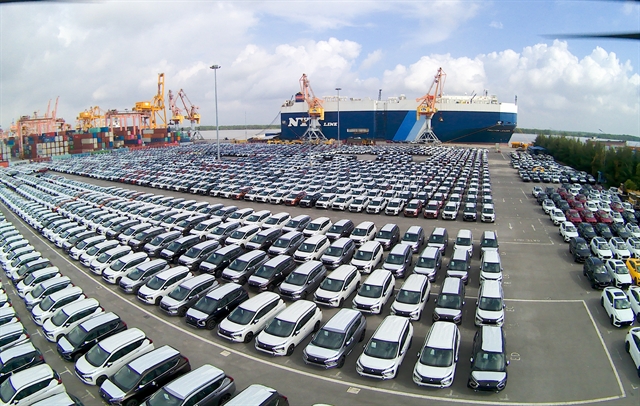ISO 14001 Environmental Management System is a globally recognized environmental management standard issued by the International Organization for Standardization (ISO), which aims to help companies systematically manage their environmental responsibilities in daily operations. The system provides a framework that enables companies to improve their environmental performance by reducing waste, reducing energy consumption, controlling pollution, and other measures while meeting the requirements of laws and regulations.
With the improvement of global environmental awareness, more and more companies have realized that good environmental management can not only improve the company’s social responsibility image, but also bring tangible economic benefits, such as reducing operating costs and reducing environmental risks.
In Vietnam, manufacturing is an important pillar industry of the national economy. With the rapid development of Vietnam’s economy and the increasing opening up to the outside world, more and more foreign companies choose to invest and set up factories in Vietnam. For these companies that want to gain a foothold and expand in the Vietnamese market, it is crucial to comply with local environmental management regulations and international standards. In particular, ISO 14001 has become one of the basic requirements of the Vietnamese market for the environmental management level of enterprises. The effective implementation of ISO 14001 can not only help companies better meet Vietnam’s strict environmental regulations, but also enhance their competitiveness in the international market.
This guide aims to provide a simplified ISO 14001 implementation path for SMEs. Through simplified steps and actionable suggestions, it helps enterprises gradually establish and improve their environmental management systems to achieve compliant operations and sustainable development. It is hoped that through this guide, more SMEs will be able to recognize the value of ISO 14001 and implement the system efficiently and at low cost in actual operations, laying a solid foundation for successful operations in Vietnam.
Core elements of ISO 14001
In the process of implementing the ISO 14001 environmental management system, enterprises need to focus on the following core elements to ensure the effective operation and continuous improvement of the system. First, the environmental policy is the basis of the enterprise’s environmental management. The enterprise needs to formulate clear environmental policies and objectives to ensure that all activities comply with environmental protection laws and regulations. This policy should reflect the company’s commitment to environmental protection and become the guiding principle for all environmental management activities.
Secondly, enterprises should set environmental goals and indicators, which should be specific, measurable and aimed at improving environmental performance, such as reducing waste generation and energy consumption. In order to achieve these goals, enterprises need to develop detailed environmental management plans, including specific measures and plans, to ensure that the goals are achieved.
The clear allocation of resources and responsibilities is also an important part of ISO 14001. Enterprises need to allocate sufficient human, material and financial resources for the implementation of the environmental management system, and clarify the responsibilities of employees at all levels to ensure the effective operation of the system. At the same time, enterprises also need to establish and maintain necessary documented information to support and prove the implementation of environmental management activities. These documents and records are not only compliance requirements, but also the basis for continuous improvement.
In daily operations, enterprises must implement and maintain necessary operational controls to ensure that all activities comply with environmental policies by developing and implementing environmental management procedures and control measures. In addition, enterprises should develop emergency preparedness and response plans to ensure that they can take prompt action in the event of an emergency to reduce environmental damage.
Finally, companies should conduct regular performance evaluation and improvement. By reviewing the performance of the environmental management system, identifying improvement opportunities and taking corrective measures, companies can continuously optimize their environmental management system and improve overall environmental performance. This continuous improvement mechanism is one of the core concepts of ISO 14001, ensuring that companies continue to make progress and improve in environmental protection.
Simplified implementation steps of ISO 14001
Step 1: Initial Assessment and Preparation
Before implementing the ISO 14001 environmental management system, companies first need to conduct preliminary assessments and preparations. This step includes understanding the company’s current environmental management status, analyzing whether existing processes and operations meet the basic requirements of environmental management, and identifying the necessity of implementing ISO 14001. Companies should designate a project leader and an implementation team to ensure that everyone from senior managers to ordinary employees can get sufficient support and resources to smoothly promote the implementation of ISO 14001.
Step 2: Develop environmental policies and objectives
Formulate clear and specific environmental policies and environmental goals based on the company’s operational characteristics and its potential impact on the environment. These policies and goals should reflect the company’s commitment to environmental protection and comply with the requirements of ISO 14001. To ensure effective implementation, environmental policies need to be widely understood and supported by all employees. Companies can make employees aware of the specific content and importance of policies through regular communication meetings, training and publicity activities.
Step 3: Establish environmental management system documents
Enterprises need to create a series of environmental management system documents according to the standard requirements of ISO 14001. These documents include management manuals, procedure documents and operation guidelines, etc., which are designed to guide the environmental management practices of enterprises. The documents should be concise and easy to understand and implement, so that all employees can follow the standard operating procedures to ensure the effective operation of the environmental management system.
Step 4: Implement environmental management control measures
In daily operations, enterprises should actively implement environmental management control measures, such as waste management, energy conservation and emission reduction. These measures help reduce the environmental impact of enterprises and achieve environmental goals. To ensure the effective implementation of these measures, enterprises should regularly organize employee training so that they are familiar with relevant environmental management requirements and strictly abide by them at work.
Step 5: Internal Audit and Performance Evaluation
Regular internal audits are one of the key links in the ISO 14001 environmental management system. Enterprises should establish an internal audit mechanism to regularly evaluate the effectiveness of the environmental management system. Through the analysis of environmental data and employee feedback, enterprises can identify areas that need improvement in current environmental management and formulate corresponding improvement measures.
Step 6: Management Review and Continuous Improvement
The company’s senior management should regularly conduct management reviews of the environmental management system to ensure that it continues to adapt to the company’s development needs and changes in the external environment. Through management reviews, companies can identify deficiencies in the environmental management system and develop and implement corresponding improvement plans. Continuous optimization and improvement will help improve the company’s environmental performance and achieve the long-term goals of environmental management.
Through the above six steps, small and medium-sized enterprises can gradually implement the ISO 14001 environmental management system to achieve effective environmental protection and sustainable development.
Key recommendations for SMEs to implement ISO 14001
When implementing the ISO 14001 environmental management system, small and medium-sized enterprises should adopt a simplified approach to reduce the difficulty of implementation based on their own scale and operational characteristics. First, enterprises can reduce complexity and paperwork by simplifying documents and procedures. Considering the limited resources of small and medium-sized enterprises, documented information should be streamlined according to the actual needs of the enterprise to ensure that all documents are easy to understand and implement, thereby avoiding unnecessary cumbersome procedures and waste of resources.
Secondly, strengthening employee training and participation is the key to the successful implementation of ISO 14001. Through regular training and communication, companies can improve employees’ awareness and sense of responsibility for environmental management, so that every employee can understand and participate in the environmental management system. Employee participation directly affects the effectiveness of the system. Therefore, companies should encourage employees to actively practice environmental protection measures in their daily work and recognize and reward their performance.
In addition, using external resources is also an effective strategy for SMEs to promote the implementation of ISO 14001. Cooperating with professional consulting agencies can provide enterprises with valuable external perspectives and professional knowledge support. This kind of cooperation can not only help enterprises understand and comply with ISO 14001 standard requirements more quickly, but also effectively reduce various costs and risks encountered during the implementation process, thereby ensuring the smooth operation of the management system.
Finally, companies should establish a mechanism for regular updates and optimization. The environmental management system needs to be continuously adjusted and optimized as the company’s operations and external environment change. Regularly evaluate and update environmental management measures and goals to ensure that the system is always consistent with the company’s development direction and environmental protection requirements. Through continuous improvement, companies can not only improve their environmental performance, but also enhance their competitiveness and sustainable development capabilities in the market.
Successful Case Studies
In Vietnam, more and more small and medium-sized enterprises are aware of the importance of implementing the ISO 14001 environmental management system and have successfully integrated it into their daily operations. The following are several successful cases that have made significant achievements in promoting environmental management and provide valuable reference experience for other companies.
Case 1: A textile company in Vietnam
This medium-sized textile company in Ho Chi Minh City faced problems such as excessive wastewater discharge and high energy consumption before implementing ISO 14001. To address these challenges, the company decided to introduce the ISO 14001 environmental management system. By establishing a complete wastewater treatment process and energy management system, the company successfully reduced wastewater discharge by 30% and energy consumption by 20%. Although the company encountered employees’ misunderstanding and resistance to the new rules and regulations in the early stages of implementation, through regular training and encouraging employees to participate in environmental improvement activities, the company gradually overcame these challenges and successfully achieved a win-win situation in environmental and economic benefits.
Case 2: An electronic component manufacturer in Vietnam
The main issue facing this electronic component manufacturer in Hai Phong City when implementing ISO 14001 was how to deal with hazardous waste. In order to comply with the ISO 14001 standard, they introduced advanced waste management technology and cooperated with local waste disposal companies to ensure that hazardous waste was safely handled. The company also conducted internal audits and promptly discovered and resolved multiple environmental risk points, such as improper storage of chemicals and lack of environmental awareness among employees. Through improvement measures and strict monitoring, the company not only reduced environmental risks, but also won environmental protection awards from the local government, further enhancing its corporate image.
Case 3: A food processing company in Vietnam
When implementing ISO 14001, a small and medium-sized food processing company in Da Nang City faced the main challenge of controlling waste and wastewater generated during the production process. The company first conducted an environmental impact assessment, identified major environmental issues, and developed a corresponding improvement plan. They optimized the production process, reduced the waste of raw materials, and installed advanced wastewater treatment equipment. Although the company also encountered difficulties with tight funds during the implementation process, they successfully overcame these obstacles by applying for government environmental protection subsidies and rationally planning the budget. In the end, the company not only met the ISO 14001 standard, but also passed multiple external audits, which improved the company’s market competitiveness.
These successful cases show that it is completely feasible for SMEs to implement ISO 14001 environmental management system in Vietnam. Although there will be some challenges, these difficulties can be overcome through effective strategies and measures. Whether it is strengthening employee training, introducing advanced technology, or cooperating with external professional organizations, the experience of these enterprises provides valuable reference for enterprises that want to implement environmental management systems in Vietnam. By learning from these successful experiences, other enterprises can also achieve a win-win situation of environmental and economic benefits and enhance their position and competitiveness in the market.
Conclusion
ISO 14001 environmental management system is of great significance to the environmental management and sustainable development of small and medium-sized enterprises. By implementing ISO 14001, small and medium-sized enterprises can not only effectively reduce environmental risks and operating costs, but also enhance their environmental image and market competitiveness. In today’s context of globalization and increasing environmental awareness, having a certified environmental management system has become one of the important conditions for enterprises to enter the international market.
For small and medium-sized enterprises, implementing ISO 14001 does not mean that they must immediately achieve full compliance with all standards. Instead, they can start with simplified steps, first formulate basic environmental policies, establish a preliminary environmental management system, and gradually promote more in-depth environmental management measures. This step-by-step approach can not only reduce the initial investment and implementation difficulties, but also allow enterprises to continuously learn and improve during the implementation process, and gradually improve the environmental management system. In this way, enterprises can not only achieve short-term environmental compliance and management optimization, but also obtain dual returns of environmental and economic benefits in the long run.
Therefore, we encourage all small and medium-sized enterprises that want to expand in the Vietnamese market to pay attention to environmental management from now on and lay a solid foundation for the sustainable development of their enterprises by implementing ISO 14001. Effective environmental management is not only a reflection of the company’s fulfillment of social responsibility, but also a guarantee for its long-term development.







